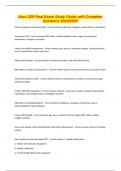Nurs 258 Final Exam Study Guide with Complete
Solutions 2024/2025
Order of physical assessment skills - Correct Answer inspection, palpation, (percussion), auscultation
Frequency of VS - Correct Answer MD orders, critical situations, after surgery, during blood
transfusions, changes in pt status
Factors that affect temperature - Correct Answer age, exercise, hormone changes, circadian rhythm,
stress, environment, illness and injury
Apical pulse location - Correct Answer 5th intercostal space, left mid-clavicular line
Why might you take an apical pulse? - Correct Answer most accurate and when pt is on cardiac meds
Factors the influence pulse - Correct Answer exercise, temperature, emotions, meds, hemorrhage,
postural changes
Factors affecting respirations - Correct Answer exercise, acute pain, anxiety, smoking, body position,
medications, neurological injury, hemoglobin function
Alterations in breathing pattern - Correct Answer bradypnea, tachypnea, hyperpnea, apnea,
hyperventilation, hypoventilation
Factors affecting BP - Correct Answer age, stress, ethnicity (AA men higher BP), meds, activity,
weight, smoking
How much change in BP would indicate orthostatic hypotension? - Correct Answer drop in 20 mmHg
systolic
How would you estimate systolic BP? - Correct Answer 1. palpate radial pulse
2. inflate cuff until pulse disappears
3. deflate cuff slowly
4. record mmHg where pulse reappears
, When should the nurse start checking BP on children? - Correct Answer not until at least 3 years old
When assessing children specifically for mental status what area's should the nurse check? - Correct
Answer head control, motor development, sensory development (7-9 months fully developed),
Babinski reflex (children fan toes, adults flex feet and toes)
LOC: alert - Correct Answer Awake or readily aroused, oriented, fully aware of external and internal
stimuli and responds appropriately
LOC: lethargic - Correct Answer not fully alert, drifts off to sleep easily, can be aroused to name but is
drowsy, responses seem slow and fuzzy, spontaneous movements are decreased
LOC: obtunded - Correct Answer transitional state between lethargy and stupor, difficult to arouse-
needs loud shout or vigorous shakes, acts confused when is aroused, speech may be mumbled and
incoherent
LOC: stupor or semi-coma - Correct Answer responds only to vigorous shaking or pain with groans,
may have appropriate motor response
LOC: coma - Correct Answer completely unconscious, no response to pain or any external
light coma = some reflex
deep coma = no motor response
LOC: delirium (Acute Confusional State) - Correct Answer clouding of consciousness, impaired
alertness, inattentive, agitation, hallucinations, disoriented
mood vs affect - Correct Answer mood is external expression of state of mind vs affect being more
internal prolonged display of feelings
Abstract reasoning - Correct Answer pondering a deeper meaning beyond the concrete and literal
Abstract reasoning involves 3 components - Correct Answer though process, thought content,
preceptions




